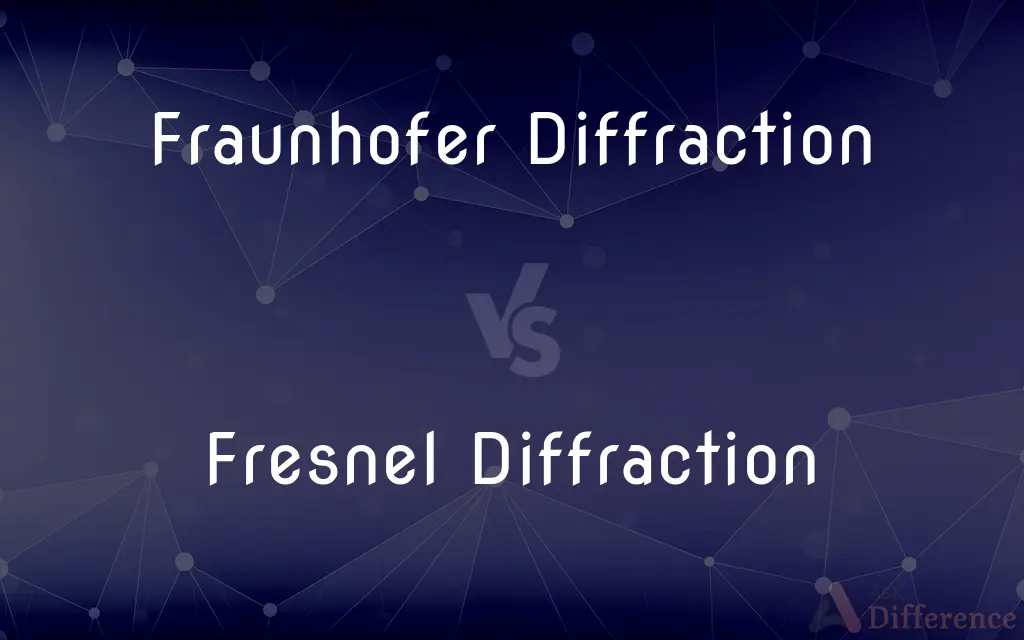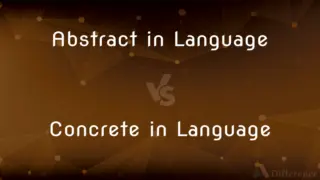Fraunhofer Diffraction vs. Fresnel Diffraction — What's the Difference?
Edited by Tayyaba Rehman — By Fiza Rafique — Published on November 17, 2023
Fraunhofer Diffraction occurs far from a diffracting object, using parallel light waves. Fresnel Diffraction considers wavefront curvature, occurring closer to the diffraction source.

Difference Between Fraunhofer Diffraction and Fresnel Diffraction
Table of Contents
ADVERTISEMENT
Key Differences
Fraunhofer Diffraction is characterized by the assumption that incident light waves are parallel, establishing a far-field diffraction scenario. Contrarily, Fresnel Diffraction does not adhere to the parallel light wave assumption and is applicable when the source and screen are relatively close, thus incorporating the effect of wavefront curvature in the analysis.
The mathematical treatment of Fraunhofer Diffraction generally employs Fourier transforms, simplifying calculations due to the parallel nature of the light waves. In contrast, Fresnel Diffraction necessitates more complex mathematical approaches, as it deals with spherical wavefronts and employs the Fresnel approximation to address the proximity of light source and observation point.
In practical scenarios, Fraunhofer Diffraction is often observed where the light source, the aperture, and the observation screen are positioned at sufficiently distant locales, creating effectively parallel incident light. Conversely, Fresnel Diffraction comes into play in scenarios where these elements are in closer proximity, hence introducing the significance of the curved wavefronts in the resultant diffraction pattern.
Fraunhofer Diffraction patterns are generally sharp and well-defined due to the distance between the diffracting object and the screen, enabling easier and clearer observations and analyses. Fresnel Diffraction patterns might exhibit more intricate details and variations in intensity due to the involvement of the varying phases of the diffracting wavefront, creating a nuanced and detailed diffraction pattern.
Fraunhofer Diffraction, recognized for its theoretical and practical simplicity in various optical applications, finds relevance in contexts like spectroscopy where clarity of diffraction patterns is pivotal. Meanwhile, Fresnel Diffraction’s applicability, particularly in the near-field region, proves invaluable in the exploration and analysis of close-range wave propagation and interference phenomena.
ADVERTISEMENT
Comparison Chart
Light Wave Characteristics
Parallel waves
Spherical wavefronts
Mathematical Approach
Fourier transforms
Fresnel approximation
Observational Distance
Far from the diffracting object
Closer to the diffracting object
Practical Applications
Spectroscopy, etc.
Near-field wave propagation studies
Distinctiveness of Pattern
Sharp and clear patterns
Nuanced patterns with variable intensity
Compare with Definitions
Fraunhofer Diffraction
Fraunhofer Diffraction deals with parallel incident light waves.
The clarity of spectra in Fraunhofer Diffraction assists in analyzing light efficiently.
Fresnel Diffraction
Fresnel Diffraction yields nuanced and variable intensity patterns.
Fresnel Diffraction reveals rich details in patterns, indicating complex interference phenomena.
Fraunhofer Diffraction
Fraunhofer Diffraction considers distant observational points.
Fraunhofer Diffraction typically employs setups with distant light sources and screens.
Fresnel Diffraction
Fresnel Diffraction employs the Fresnel approximation in calculations.
The Fresnel Diffraction computations incorporate the Fresnel approximation to handle curved wavefronts.
Fraunhofer Diffraction
Fraunhofer Diffraction applies Fourier transform methodologies.
In Fraunhofer Diffraction, Fourier transforms simplify the computational processes involved.
Fresnel Diffraction
Fresnel Diffraction is pivotal for studying near-field wave phenomena.
Fresnel Diffraction provides insights into light behavior and wave propagation in close-proximity setups.
Fraunhofer Diffraction
Fraunhofer Diffraction displays defined, sharp patterns.
The precision of Fraunhofer Diffraction patterns facilitates optimal spectroscopic analysis.
Fresnel Diffraction
Fresnel Diffraction involves accounting for wavefront curvature.
Fresnel Diffraction can be observed when analyzing the behavior of light in near-field situations.
Fraunhofer Diffraction
Fraunhofer Diffraction is commonly used in spectroscopy.
Fraunhofer Diffraction enables scientists to decode the composition of distant stars through spectroscopy.
Fresnel Diffraction
Fresnel Diffraction deals with source and screen proximity.
Experiments demonstrating Fresnel Diffraction often have closely placed light sources and screens.
Common Curiosities
Are Fourier transforms utilized in Fresnel Diffraction analysis?
No, Fresnel Diffraction typically employs the Fresnel approximation due to the involvement of curved wavefronts.
Can Fraunhofer Diffraction analyze close-proximity light propagation?
Fraunhofer Diffraction is ideally suited for far-field scenarios and is not optimal for close-proximity light analysis.
Is the Fresnel approximation relevant to Fraunhofer Diffraction?
No, Fraunhofer Diffraction uses Fourier transforms, as it assumes light waves are parallel.
What characterizes Fraunhofer Diffraction?
Fraunhofer Diffraction involves parallel incident light waves and occurs at a significant distance from the source.
How does Fresnel Diffraction differ in light wave characteristics?
Fresnel Diffraction deals with curved, spherical wavefronts, typically observed in near-field scenarios.
Share Your Discovery

Previous Comparison
Abstract in Language vs. Concrete in Language
Next Comparison
Soybean Oil vs. Vegetable OilAuthor Spotlight
Written by
Fiza RafiqueFiza Rafique is a skilled content writer at AskDifference.com, where she meticulously refines and enhances written pieces. Drawing from her vast editorial expertise, Fiza ensures clarity, accuracy, and precision in every article. Passionate about language, she continually seeks to elevate the quality of content for readers worldwide.
Edited by
Tayyaba RehmanTayyaba Rehman is a distinguished writer, currently serving as a primary contributor to askdifference.com. As a researcher in semantics and etymology, Tayyaba's passion for the complexity of languages and their distinctions has found a perfect home on the platform. Tayyaba delves into the intricacies of language, distinguishing between commonly confused words and phrases, thereby providing clarity for readers worldwide.












































